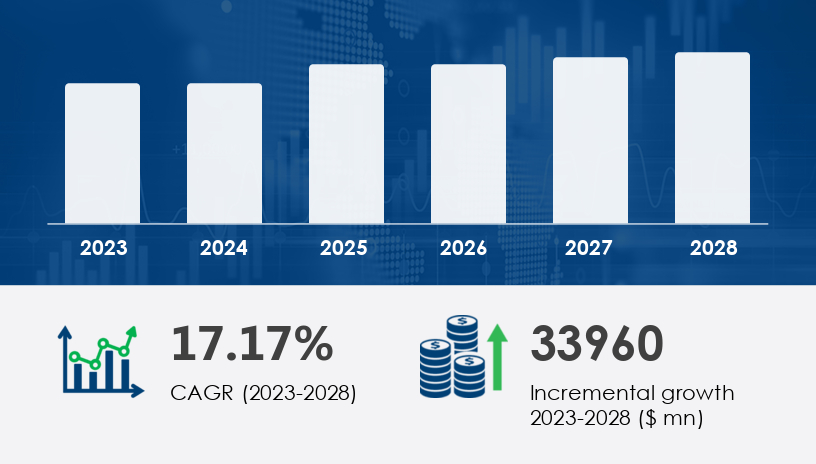Offshore Wind Power Market to Grow by USD 33.96 Billion (2024-2028),Vendor Strategies Boost Growth, AI-Powered Market Evolution Report - Technavio
The offshore wind power market is projected to expand by USD 33.96 billion between 2024 and 2028, growing at a CAGR of 17.17%. This growth is driven by increasing global electricity demand, supportive government policies, and declining Levelized Cost of Energy (LCOE) for wind power. Offshore wind turbines and wind power technology continue to advance, with floating wind systems playing a crucial role in enhancing offshore wind efficiency. Offshore wind farms are expanding as governments implement wind power regulations to promote renewable wind solutions. Despite these advancements, challenges such as competition from alternative energy sources, environmental concerns, and high capital investment requirements persist. Wind energy costs remain a critical factor, impacting project feasibility and investment decisions. Leading wind turbine manufacturers are focused on green wind innovations to improve efficiency and reduce costs, further driving market expansion.Key insights into market evolution with AI-powered analysis. Explore trends, segmentation, and growth drivers- View Free Sample PDF

Market Segmentation
By Type
-
Monopile
- The monopile segment is anticipated to hold a significant market share during the forecast period.
- Monopiles are cylindrical steel tube structures installed in the seabed, offering a simple design suitable for shallow waters (up to 30 meters).
- Variations include drilled monopiles and drilled concrete monopiles, which lower the foundation's weight and simplify installation.
- Rapid deployment and technological advancements in monopile structures will contribute to market growth.
-
Jacket
- A jacket foundation consists of a lattice structure with multiple legs, offering enhanced stability.
- Suitable for medium to deep waters, making it a preferred choice for regions with varying seabed conditions.
- Increasing deployment of jacket structures in offshore wind farms will support market growth.
-
Others
- Includes gravity-based foundations, tripod, and suction bucket foundations.
- These structures are used in specific seabed conditions and deep-water installations.
By Product Type
-
Fixed Structure
- Installed directly on the seabed, providing high stability.
- Commonly used in shallow and medium-depth waters.
-
Floating Structure
- Utilized in deep-water installations, where fixed foundations are not feasible.
- Floating wind farms are gaining popularity due to their ability to harness stronger winds further offshore.
Request Sample of our comprehensive report now to stay ahead in the AI-driven market evolution!
Regional Market Trends
Europe (49% of global market growth)
- UK
- Germany
- France
- Rest of Europe
Europe leads offshore wind installations, with the UK and Germany at the forefront. Declining offshore power prices, government incentives, and technological advancements are expected to drive further market expansion. Upcoming auctions and tariff reductions (anticipated at USD 0.18 per kW) will further boost market growth in the region.
North America
APAC
South America
Middle East & Africa
- Saudi Arabia
- South Africa
- Rest of Middle East & Africa
Market Dynamics
Key Market Drivers
- Rising Global Electricity Demand
- According to the International Energy Agency (IEA), global electricity demand grew 4.6% in 2021, driven by economic growth in China, the U.S., and India.
- Forecasts predict a twofold increase in electricity demand by 2040, underscoring the need for offshore wind power investments.
Significant Market Trends
- Surging Demand for Clean Energy Technologies
- The extensive use of fossil fuels has significantly increased global CO₂ emissions from electricity and heat generation (42% of total CO₂ emissions in 2022).
- Wind and solar power saw double-digit growth in 2021, primarily led by China, Europe, and the U.S.
- The rising adoption of renewable energy sources is accelerating offshore wind power expansion.
Major Market Challenges
- Competition from Alternative Energy Sources
- Fossil fuels (oil, coal, and natural gas) continue to dominate the global energy mix.
- Clean coal technologies, including supercritical and ultra-supercritical coal-fired power plants, support the continued use of coal-fired power generation.
- High installation costs and lower power output compared to fossil fuels remain key challenges for offshore wind power projects.
Discover how AI is revolutionizing market trends- Get your access now!
Key Players
Leading Companies in Offshore Wind Power
- CAPE Holland BV
- China Steel Corp.
- Dongfang Electric Corp.
- Doosan Corp.
- Erndtebcker Eisenwerk GmbH & Co KG
- General Electric Co.
- Hyosung Heavy Industries Corp.
- Hyundai Heavy Industries Co. Ltd.
- JDR Cable Systems Ltd.
- Lamprell Plc
- Nexans SA
- NKT AS
- Nordex SE
- Senvion Wind Technology Pvt. Ltd.
- Siemens Gamesa Renewable Energy SA
Future Insights
Advancements in offshore wind technology, growing investments, and favorable policies will drive market expansion. Floating offshore wind farms and deep-water installations are expected to become key areas of development. As governments implement stricter renewable energy targets, offshore wind power will play a crucial role in meeting clean energy demands worldwide.